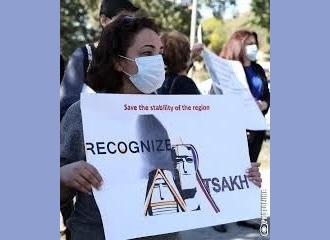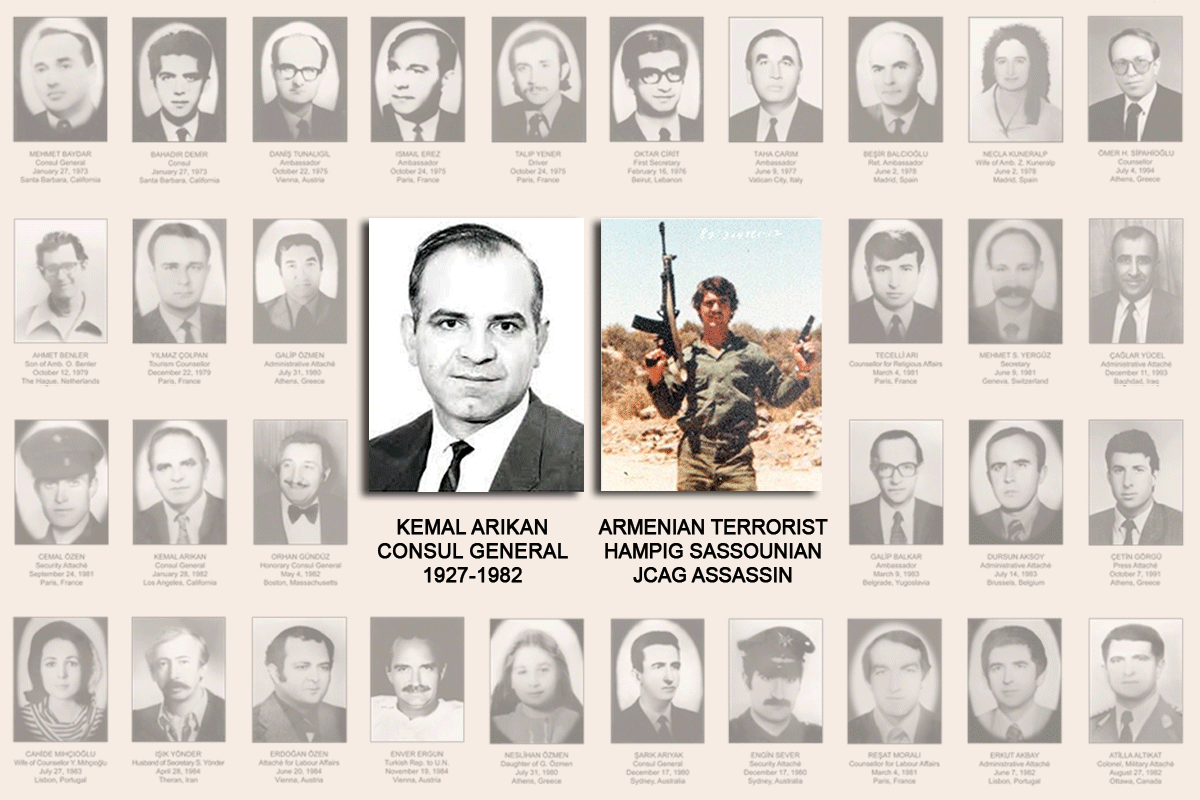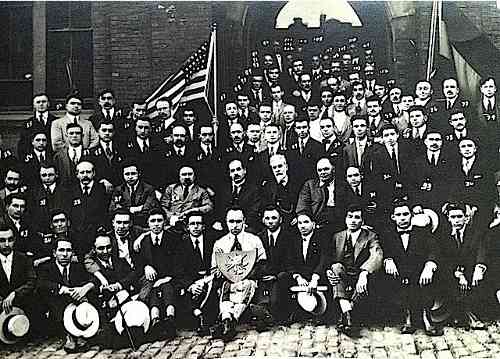
*AVİM’s note: This article was penned before the armistice agreement of 9 November 2020 that was signed between Azerbaijan, Armenia, and Russia.
Shortly after the outbreak of large-scale hostilities between Armenia and Azerbaijan over Karabakh on 27 September 2020, a social media campaign for the international recognition of de facto Armenian administration in Karabakh was launched by the Armenian side. Armenian officials subsequently joined the campaign and began propounding this prospect. Eventually, the campaign turned into something more than a civil social media initiative and the international recognition of the de facto Armenian administration in Karabakh came to be the official position of the Armenian side. This is, indeed, a new development and deserves attention because it is seen that we will now witness a new set of arguments from the Armenian side, which will change the parameters of the conflict and the prospects of its resolution.
What the Armenian side proposes as the justification of the recognition of the de facto entity in Karabakh is the doctrine of remedial secession. The legal validity of this doctrine was analyzed in an article that was published on 27 October 2020. This legal-theoretical analysis demonstrated that the doctrine of remedial secession as a basis for unilateral secession (or unilateral external self-determination, meaning the same thing) is highly controversial both theoretically and practically, and has, at best, little legal validity. This article concluded with the assertion that a more constructive way to secure the rights of minority groups is to search for ways to strengthen democracy and constitutional citizenship. If this cannot be achieved because of the inconformity of the government of the parent state, internal self-determination is the valid and politically sounder option with a more solid legal basis and wider practice.
As the follow up to this article, the current article rests on a hypothetical situation and scrutinizes whether remedial secession could have been applicable to the Karabakh case even if this doctrine was legally valid doctrine and unilateral secession was a right and a norm.
Can the Karabakh Conflict be framed within the Colonial Paradigm?
As stated in the previous article, external self-determination was established as a right for colonial subjects under foreign colonial subjugation. Therefore, the most direct way to argue for the unilateral secession of Karabakh would be to frame the Karabakh conflict within the colonial paradigm. In other words, if Karabakh was a colony of Azerbaijan, its unilateral secession could be legally justified. For this reason, it is worthwhile to briefly touch upon whether the Karabakh conflict could be framed within the colonial paradigm before moving on to examining the applicability of remedial secession to the Karabakh case.
The answer to the questions posed above is quite straightforward; Karabakh cannot be regarded as a colony of Azerbaijan either historically, legally, or politically, nor can Azerbaijan be regarded as a colonial power over Karabakh. In the relevant literature, there is nothing indicating the colonial paradigm being applied to the Karabakh case. Accordingly, external self-determination as a right of colonial subjects cannot be granted to Karabakh Armenians.
This being the conclusive basis, there may be pseudo-scholarly attempts to frame the Karabakh conflict within the colonial paradigm. Considering this rather politically motivated possibility, one basic historical fact should be underlined as a reminder. This fact is that the emergence of the Armenians in the Caucasus as a demographically and politically significant group dates back to some two hundred years. In the early 19th century, when the Russian Empire invaded the Caucasus, Russian authorities encouraged Armenians in Eastern Anatolia and Iran to settle in the region in order to alter the demographic and political balances in this newly invaded territory to the disadvantage of its indigenous peoples. The objective of this policy was to weaken the indigenous Caucasus peoples, which St. Petersburg viewed as untrustworthy and troublesome, to ensure the incorporation the region with the Russian Empire by populating this region with new and loyal subjects. Put differently, the advent of the Armenian population in the Caucasus is itself a result of the invasion of the region by a foreign power, that is, the Russian Empire, as this population was utilized as an asset to secure Russia’s hold on the newly captured territories. Therefore, if the Karabakh conflict is to be framed within the colonial paradigm, Armenians in the Caucasus should be identified as the colonizers vis-à-vis the indigenous peoples, and not the other way around.
The Armenian Argument for Remedial Secession
It should be underlined that Armenian officials began arguing for remedial secession on the grounds of the alleged intention of Azerbaijan to exterminate the Armenians in Karabakh. The allegations of the military involvement of Turkey and jihadist mercenaries in the hostilities are used to verify this alleged intention. Likewise, frequent references to the 1915 events, which the Armenian side defines as genocide, in the statements of the Armenian officials are also utilized for the same purpose. However, this line of argumentation has several major pitfalls and does not really form a viable reasoning that would legitimize remedial secession.
First, even if 1915 events constitute a genocide (at this point it should be underlined that the characterization of the 1915 events as genocide is a disputed approach and there is no valid court judgement that establishes those events as a genocide), its alleged perpetrators were the individual high ranking officials of the Ottoman Empire of the time, not the Republic of Azerbaijan. Therefore, Azerbaijan cannot be held responsible for this alleged genocide. Accordingly, the genocide argument is irrelevant to Azerbaijan or the Karabakh conflict.
This being crystal clear, apparently, the Armenian side brings forward the genocide argument by underlining the ethnic identity between the Turks of Turkey and Azerbaijan. The subtext of this argument is that Turks as an ethnicity are genocidal perpetrators; hence Azerbaijanis, who are mostly ethnically Turks, are, by definition, genocidal perpetrators who are willing and ever ready to massacre Armenians when they get that opportunity. The unreasonableness and racism of this line of thinking and argumentation should be noted.
Secondly, the military involvement of Turkey and the existence of jihadist mercenaries among the Azerbaijani troops are so far unproved claims. Even if Turkey was involved militarily in the hostilities and there were jihadist mercenaries in Azerbaijan, these cannot be asserted as the proof of the intention of the Azerbaijani side to exterminate the Armenians in Karabakh. There are neither statements of the Azerbaijani officials nor any facts on the ground that Azerbaijan has such an intention. What the statements of the Azerbaijani officials and the facts on the ground demonstrate is that the objective of the Azerbaijanis is to regain its territories occupied by Armenia for the last thirty years or so. The difference between the alleged objective of annihilation of the Armenians and the goal of regaining internationally recognized territories is obvious and should not require elaboration.
Still, there may be one point that would need scrutinization. This is the argument of the Armenian side that Armenians would not be given any opportunity to live under the Azerbaijani rule and for this reason reestablishment of the Azerbaijani rule over Karabakh would amount to the ethnic cleansing of the Armenian from this territory. This line of argumentation ignores a couple of facts that invalidate the ethnic cleansing argument.
First, Armenians have lived under Azerbaijani rule for centuries.
Second, according to the 2009 census, about 8.4% of the Azerbaijani population is composed of non-ethnic Azerbaijanis (as opposed to 1.9% non-ethnic Armenians in Armenia according to 2011 census). There are no minority issues in Azerbaijan.
Third, one of the arguments of the Armenian side is that during the Soviet times, Armenians in Azerbaijan and particularly in Nagorno Karabakh faced ethnic discrimination. In fact, this argument has been used to justify the occupation of Nagorno Karabakh and the adjacent territories. Yet, facts invalidate this argument. During the Soviet times, Nagorno Karabakh was an autonomous oblast within Azerbaijan with its own soviet composed of ethnic Armenians. The language of instruction of the vast majority of the schools was either Armenian or Russia and people could freely choose which school they wanted to send their children to. Textbooks published in Soviet Armenia were used in the Armenian schools in Nagorno Karabakh. The economic conditions in the region were better than the rest of Azerbaijan. Armenian side often underlines that the percentage of the Armenian population in Nagorno Karabakh decreased during the Soviet times as a proof Baku’s discrimination against the Karabakh Armenians. However, ethnic homogenization of the republics in the Soviet Union was a general trend, not a particular fact about Nagorno Karabakh. Besides, there was a numerous and well-off Armenian community in Azerbaijan and particularly in the capital city of Baku. In brief, there are no solid facts that verify the Armenian claim of ethnic discrimination against Armenians in Soviet Azerbaijan. Even if there were to be records showing mass, systematic, and gross violations against Armenians in Soviet Azerbaijan or within the precedent Azerbaijani political entities, legally speaking, Republic of Azerbaijan could not be held responsible. This is because in terms of legal identity, Republic of Azerbaijan is not the continuing state of these political entities.
Fourth, we cannot speak of violations against the Armenian population in the Republic of Azerbaijan for the simple fact that, at the time Republic of Azerbaijan gained its independence and took on stage as a recognized state, the vast majority of the Armenians in Azerbaijan except for the Nagorno Karabakh had already left the country. Hence, there was no possibility for the materialization of any crime against Armenians since there was no potential victim group, i.e., Armenian community whose human rights and other rights to be violated, living under the Azerbaijani rule. To explain this by using lay language, one cannot harm another person, if that potential victim is nonexistent. Likewise, we cannot speak of violations of the rights of Armenians after the 1994 ceasefire for the simple fact that Baku has no control over its territories populated by the Armenians.
Fifth, the Armenian side claims atrocities perpetrated by Azerbaijan against the Karabakh Armenians during the war, ignoring the atrocities inflicted upon the Azerbaijanis by itself in the same period. Even if these claims are truthful, these alleged war time atrocities amount to war crimes, that is, a set of crimes that are categorically different from the violations that the doctrine of remedial secession aims to remedy. In other words, even if Azerbaijan had committed war crimes, they necessitate different sort of correction such as the punishment of the perpetrators and compensations.
Sixth, while hostilities were continuing, Azerbaijani President İlham Aliyev several times stated to the international media that Azerbaijan is ready to provide security guarantees as well as certain forms of autonomy to the Armenians in Karabakh. In fact, since 1990s, Azerbaijan has accepted the formula of ‘outmost autonomy for the Karabakh Armenians,’ meaning that Baku does not oppose internal self-determination.
One may still argue that, no matter what guarantees are given to Armenians, they would not want to live under the Azerbaijani rule. This may be a possibility but the emigration of the Armenians from Karabakh for not wanting to live under the Azerbaijani rule would amount to voluntary emigration, which cannot be defined as ethnic cleansing. Likewise, Baku cannot be held responsible for such an emigration, provided that it keeps its promises about security and other guarantees. Overall, the ethnic cleansing argument is just a prediction that has no solid basis. It has only propaganda value and cannot be taken as legal argument.
Besides the factual side, one should also examine whether the alleged possibility of genocide or ethnic cleansing validates remedial secession from a legal point of view. Certainly, this issue could be discussed at length, but sticking to the definition of remedial secession, it can be suggested that as the wording shows, remedial secession is a remedial doctrine and not a preventive one. As the previous article showed, the doctrine of remedial secession lays the theoretical-legal basis of unilateral external self-determination in cases of human rights abuses and absence of representation of a specific people within a state. In order for remedial secession to become a possibility, these violations should exceed a certain threshold, meaning they should be mass, systematic, and gross. As a remedy, remedial secession gains legal relevance only when violations exceeding a certain threshold are materialized, not before that point. Therefore, Armenian argument that is based on the claim of the possibility of genocide or ethnic cleansing is legally invalid. Obviously, any possibility of human rights abuses should be addressed before they materialize, yet the mechanism for that is not remedial secession.
The Question of the Exhaustion of All Other Remedies
The factual and legal fallacies of the Armenian argument about remedial secession are obvious. We may, nevertheless, continue our examination. As mentioned in the previous article, remedial secession is the last resort - an ultimum remedium, meaning that remedial secession may be applied only after all the other possible remedies are exhausted and only when no other alternative is left out to bring an end to the mass, systematic, and gross violations with respect to human rights and representation. Hence, what should be next is to examine whether all other remedies to resolve the Karabakh conflict have been exhausted.
As mentioned above, besides other possible solutions, internal self-determination is the legally valid norm to remedy human rights and other violations. As previously stated, Azerbaijan accepts internal self-determination for the Karabakh Armenians. On the other hand, the Armenian side rejects this solution. This reveals two facts. First, the legally valid and applicable remedy to the alleged violations has not been exhausted. This means that, according to the doctrine, remedial secession has not yet become an option. This being the decisive point, second, it should be noted that it is not Azerbaijan but Armenia who rejects this applicable norm, which would also resolve the contradiction between the principles of territorial integrity and self-determination. As such, the party that blocks the probable remedy for the alleged violations and peaceful resolution of the conflict is Armenia with its maximalist stance.
Secondly, as to the exhaustion of all other remedies, the OSCE Minsk Group has been the primary mechanism of this process since 1992. In plain words, all experts and observers are of the opinion that the OSCE Minsk Group has proved to be an ineffective mechanism in performing its conflict resolution duty. This means that neither an effective conflict resolution process has not been performed nor more efficient mechanisms have been tried. This means that not all the possibilities of the resolution of the conflict have been exhausted. For this reason, too, at the time being, remedial secession ‘as the last resort’ cannot be argued for.
The Imperative of Legality
As the previous article demonstrated, external self-determination via remedial secession cannot be achieved through methods that breach international law such as unlawful armed uprising or terrorism. This is the logical outcome of the principle of ex injuria jus non oritur - law/right does not arise from injustice or unjust acts cannot create law/right. Therefore, whether the secessionist movement in Nagorno Karabakh followed legal ways is a central question with respect to the validity of the arguments for remedial secession.
Although it has a longer history, the Karabakh conflict began by the end of 1980s when Mikhail Gorbachev initiated glasnosts and perestroika in the Soviet Union. Encouraged by the reform movement, Armenians in Soviet Armenia and Nagorno Karabakh began campaigning for the latter’s unification with the former.
Approximately in May 1989, armed Armenian militia groups began to show off in Nagorno Karabakh. Within a year, the amount of military equipment that had been transferred from Armenia to Nagorno-Karabakh reached a significant volume. The armed activities of the Armenian militia in Nagorno Karabakh rose to a substantial level by 1991. It should be noted that, there are some indications that Armenians began preparing for a guerilla warfare starting from 1986, approximately a year before August 1987 when the Armenian Academy of Sciences in Yerevan issued a petition to Moscow requesting the transfer of Nagorno Karabakh to Soviet Armenia.
In November 1987, the first serious acts of violence erupted between the Azerbaijanis and the Armenians in the Kapan region of Armenia. In January 1988, Azerbaijanis in this region were expelled to Azerbaijan. This was the first case of forced displacement within the framework of the Karabakh conflict. In the following month, Azerbaijanis in Armenia were subsequently expelled from Armenia in two waves. In March 1988, once again Azerbaijanis in Armenia, particularly those in Ararat and Zangezur regions, were expelled en masse. This was followed by the displacement of the Azerbaijanis in the Turkey-Armenia border area, again in the Ararat region in Armenia, and in Khankendi in Nagorno Karabakh in June 1988. The expulsions continued throughout November and by the end of this month Azerbaijani population in Armenia had completely disappeared. Overall, more than 200,000 Azerbaijanis were expelled from Armenia before the conflict evolved into a war. As shall be mentioned below, deportations from Nagorno Karabakh and the surrounding regions continued after the conflict evolved into a war between Azerbaijan and Armenia following the dissolution of the Soviet Union.
In addition to these, it should also be underlined that on 23 March 1988 the Supreme Soviet, the highest decision making authority in the Soviet Union, issued a decision that rejected the demand of Nagorno-Karabakh’s unification with Armenia in the light of Article 78 of the Soviet Constitution. On 28 June and 18 July in the same year, Gorbachev and the Presidium of the Supreme Soviet made statements affirming this decision. In brief, Armenian demands were rejected by the highest Soviet authorities on constitutional grounds.
These historical facts are of crucial importance with respect to the applicability of the doctrine of remedial secession. They reveal that the Armenian secessionist movement from the beginning relied on violence, and criminal and illegal acts. The highest legal authority of the time found the Armenian demand to be unconstitutional. For these reasons, according to the doctrine, remedial secession cannot rise as an option for the ex injuria jus non oritur principle.
The Inadmissibility of Third-Party Interference
As discussed in the previous article, international documents include clauses and remarks about the inadmissibility of external interference in self-determination conflicts. The relevant literature includes warnings about the possibility of the third actors to agitate secessionist movements and instrumentalize conflicts for their own objectives, which may jeopardize not only interstate relations but also global peace and sustainability of the international system.
All the facts undeniably demonstrate that before the dissolution of the Soviet Union, Soviet Armenia was involved in the secessionist movement in Nagorno Karabakh and afterwards, the Republic of Armenia became the patron of the de facto Armenian administration in Karabakh. Furthermore, the Nagorno Karabakh conflict emerged not as an independence movement but as a movement seeking this region’s incorporation into Armenia. In fact, the unification of Karabakh with Armenia has been the official stance of the Armenian side at least until 1993. Later, the independence of Nagorno Karabakh became the main discourse of the Armenian side. However, facts clearly demonstrate that the de facto Armenian administration in Karabakh is not an independent entity. It relies on the military, economic, and political support of the Republic of Armenia. As to this point, the European Court of Human Rights, in its verdict on Chiragov and others v. Armenia in 2016 confirmed that Nagorno-Karabakh and the surrounding territories are under Armenia’s occupation by highlighting Armenia’s “effective control” in those regions. The Court decided that:
All of the above reveals that the Republic of Armenia, from the early days of the Nagorno-Karabakh conflict, has had a significant and decisive influence over the “NKR”, that the two entities are highly integrated in virtually all important matters and that this situation persists to this day. In other words, the “NKR” and its administration survives by virtue of the military, political, financial and other support given to it by Armenia which, consequently, exercises effective control over Nagorno-Karabakh and the surrounding territories, including the district of Lachin.
Accordingly, the Court dismissed Armenian government’s “objection concerning the jurisdiction of the Republic of Armenia over Nagorno-Karabakh and the surrounding territories.” Needless to say, the four UN Security Council resolutions issued in 1993 are the basic documents that attest Armenia’s occupation of the Azerbaijani territory.
These reveal that the matter at hand is not the self-determination of the Karabakh Armenians, but the occupation of some parts of the internationally recognized territory of Azerbaijan by Armenia. This fact by itself dismisses remedial secession as a relevant doctrine with respect to Karabakh conflict. Even if the issue at hand was not occupation but self-determination, the key involvement of Armenia also shadows the possibility of the application of the doctrine of remedial secession.
The Fallacy of Remedying One Violation by Perpetuating Another
Whereas before the beginning of the Karabakh conflict, Azerbaijanis constituted 22% of the Nagorno Karabakh’s population, today there are no Azerbaijanis in this region. The occupation of Nagorno Karabakh and the seven surrounding regions, where very few or no Armenians were living, resulted in a total of some 780,000 Azerbaijani IDPs (this figure does not include about 200,000 Azerbaijani refuges from Armenia). Today, about 13% of the Azerbaijani population is composed of IDPs and refugees.
One of topics that has been discussed under the umbrella of the OSCE Minsk Group is the return of the Azerbaijani IDPs to their lands. However, the Armenian side has been rejecting this prospect by alleging Armenians and Azerbaijanis cannot live together. At the same time, Armenia carries out a policy of illegally settling ethnic Armenians from the Middle East to the occupied territories. This policy amounts to a permanent seizure of the lands and other properties of the Azerbaijani IDPs.
As said in the previous article, the doctrine of remedial secession is the product of the post-Cold War era, in which concerns about human rights were raised and international human rights law gained currency. It is a doctrine based on the prospect of securing human rights at large. However, it is obvious that entitling the right to external self-determination to the de facto Armenian administration in Karabakh via remedial secession will mean the elimination of the prospect of the return of the Azerbaijani IDPs to their lands and perpetuation of the seizure of their properties. Such an act would mean to approval of the violations of human and property rights and other relevant rights the Azerbaijani IDPs and their descendants. For this reason, the right to remedial secession for the de facto entity in Karabakh is in contradiction to the logic and purpose of this doctrine. Certainly, this contradiction arises from the illegality of the actions of the Armenian side, another reason why remedial secession cannot be applied to the Karabakh case as discussed above.
Conclusion
The previous article demonstrated that the doctrine of remedial secession as a basis for unilateral secession is highly controversial both theoretically and practically, and has, at best, little legal validity. This article, as the follow up, reveals that even if remedial secession had validity, it could not be applied to the Karabakh case. In sum, these two articles display that remedial secession cannot be a means to resolve the Karabakh conflict. On the contrary, it is apparent that application of this doctrine would result in more contradictions and conflicts than those already exist. The application of this doctrine to the Karabakh case would have wider consequences, too. That is, it would mean a clear and dramatic infringement of international law. Because international law is one of the chief pillars of the liberal international order, its infringement would deniably have disruptive effects on the latter.
*Photo: Aravot
© 2009-2025 Center for Eurasian Studies (AVİM) All Rights Reserved
No comments yet.
-
 THE GRAIN INITIATIVE AND THE BLACK SEA SECURITY - II
THE GRAIN INITIATIVE AND THE BLACK SEA SECURITY - II
Turgut Kerem TUNCEL 03.08.2023 -
 THE BACKTRACK OF AUSTRIA AND LUXEMBURG ON THE CHARACTERIZATION OF THE 1915 EVENTS AS GENOCIDE
THE BACKTRACK OF AUSTRIA AND LUXEMBURG ON THE CHARACTERIZATION OF THE 1915 EVENTS AS GENOCIDE
Turgut Kerem TUNCEL 21.10.2015 -
 PASHINYAN'S GERMANY VISIT
PASHINYAN'S GERMANY VISIT
Turgut Kerem TUNCEL 09.03.2023 -
 THE KARABAKH CONFLICT AND THE LAWFARE OF ARMENIA: ARMENIA’S CAMPAIGN FOR REMEDIAL SECESSION (I)
THE KARABAKH CONFLICT AND THE LAWFARE OF ARMENIA: ARMENIA’S CAMPAIGN FOR REMEDIAL SECESSION (I)
Turgut Kerem TUNCEL 27.10.2020 -
 BECOMING THE PART OF THE PROBLEM: THE FAULTY POLICIES OF THE WEST IN EURASIA AND THE SOUTH CAUCASUS
BECOMING THE PART OF THE PROBLEM: THE FAULTY POLICIES OF THE WEST IN EURASIA AND THE SOUTH CAUCASUS
Turgut Kerem TUNCEL 11.08.2015
-
 ATTEMPTS TO PUT PUTIN ON TRIAL: BUT WHAT ABOUT THOSE GUILTY IN THE WEST?
ATTEMPTS TO PUT PUTIN ON TRIAL: BUT WHAT ABOUT THOSE GUILTY IN THE WEST?
Onur URAZ 03.05.2023 -
 THE DECISION TO RELEASE SASSOUNIAN
THE DECISION TO RELEASE SASSOUNIAN
Hazel ÇAĞAN ELBİR 16.03.2021 -
 A MOVIE REVIEW: AURORA’S SUNRISE
A MOVIE REVIEW: AURORA’S SUNRISE
Hazel ÇAĞAN ELBİR 07.12.2023 -
 ARMENIAN JOURNEY FROM “OPERATION NEMESIS”, ASALA MURDERS AND KHOJALY MASSACRE TO PRESENT DAY “ARMENOPHOBIA” FABRICATION
ARMENIAN JOURNEY FROM “OPERATION NEMESIS”, ASALA MURDERS AND KHOJALY MASSACRE TO PRESENT DAY “ARMENOPHOBIA” FABRICATION
AVİM 06.03.2019 -
 THE RISE OF CHRISTIAN NATIONALISM
THE RISE OF CHRISTIAN NATIONALISM
Mehmet Oğuzhan TULUN 02.11.2022
-
25.01.2016
THE ARMENIAN QUESTION - BASIC KNOWLEDGE AND DOCUMENTATION -
12.06.2024
THE TRUTH WILL OUT -
27.03.2023
RADİKAL ERMENİ UNSURLARCA GERÇEKLEŞTİRİLEN MEZALİMLER VE VANDALİZM -
17.03.2023
PATRIOTISM PERVERTED -
23.02.2023
MEN ARE LIKE THAT -
03.02.2023
BAKÜ-TİFLİS-CEYHAN BORU HATTININ YAŞANAN TARİHİ -
16.12.2022
INTERNATIONAL SCHOLARS ON THE EVENTS OF 1915 -
07.12.2022
FAKE PHOTOS AND THE ARMENIAN PROPAGANDA -
07.12.2022
ERMENİ PROPAGANDASI VE SAHTE RESİMLER -
01.01.2022
A Letter From Japan - Strategically Mum: The Silence of the Armenians -
01.01.2022
Japonya'dan Bir Mektup - Stratejik Suskunluk: Ermenilerin Sessizliği -
03.06.2020
Anastas Mikoyan: Confessions of an Armenian Bolshevik -
08.04.2020
Sovyet Sonrası Ukrayna’da Devlet, Toplum ve Siyaset - Değişen Dinamikler, Dönüşen Kimlikler -
12.06.2018
Ermeni Sorunuyla İlgili İngiliz Belgeleri (1912-1923) - British Documents on Armenian Question (1912-1923) -
02.12.2016
Turkish-Russian Academics: A Historical Study on the Caucasus -
01.07.2016
Gürcistan'daki Müslüman Topluluklar: Azınlık Hakları, Kimlik, Siyaset -
10.03.2016
Armenian Diaspora: Diaspora, State and the Imagination of the Republic of Armenia -
24.01.2016
ERMENİ SORUNU - TEMEL BİLGİ VE BELGELER (2. BASKI)
-
AVİM Conference Hall 24.01.2023
CONFERENCE TITLED “HUNGARY’S PERSPECTIVES ON THE TURKIC WORLD"









